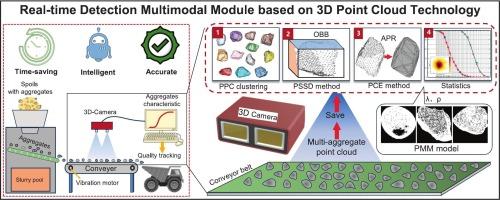基于三维点云技术的实时检测多模态模块对建筑垃圾处理集料颗粒特性的评价
IF 7.1
2区 环境科学与生态学
Q1 ENGINEERING, ENVIRONMENTAL
引用次数: 0
摘要
施工废料是在施工活动中产生的,通常含有骨料和泥浆,需要评估尺寸分布(级配)以进行再利用。使用方孔筛的传统方法效率低下且劳动密集。本研究介绍了一种基于三维扫描技术的多模态智能级配检测模块,以取代传统的筛分技术。提出的粒子点云聚类算法通过自适应点间距优化,在2s内实现了对多粒子点云近100%的分割精度。一种筛分粒度测定方法保证了粒度分级精度超过93.0%。将粒子表面重建算法集成到粒子特征提取(PCE)方法中,解决了未扫描粒子底表面体积计算的难题,为计算粒子几何提供了一种新的策略,涵盖了传统的分析。为了简化体积计算并绕过单个粒子重建,我们开发了一种将定向边界盒体积与通过PCE方法获得的粒子形态参数(λ)相结合的体积预测方法。此外,粒子质量修正模型通过将预测的体积与确定的密度相乘来确定总质量。该模型显著降低了梯度误差,平均误差小于1.2%,并得到了实验验证。实验结果也证实了该方法实现了实时、二级检测,满足了施工现场的典型应用需求。这项研究预计将有利于其他工业过程,例如采矿业的颗粒筛选,因为关于颗粒特性的资料对该部门同样至关重要。本文章由计算机程序翻译,如有差异,请以英文原文为准。

Evaluation of the particle characteristics of aggregates from construction spoils treatment through a real-time detection multimodal module based on 3D point cloud technology
Construction spoils are generated during construction activities and typically contain aggregates along with mud, requiring size distribution (gradation) assessment for reuse. Conventional methods using the square opening sieves are inefficient and labor-intensive. This study introduced an intelligent multi-modal module primarily for gradation detection based on 3D scanning technology to replace traditional sieve techniques. The proposed Particle Point Cloud Clustering algorithm achieved nearly 100% segmentation accuracy for multi-particle point clouds within 2 s through adaptive point-spacing optimization. A Particle Sieving Size Determination method ensured particle size classification accuracy exceeding 93.0%. A particle surface reconstruction algorithm was integrated into the Particle Characteristics Extraction (PCE) method to address the challenge of volume calculation for unscanned particle bottom surfaces, providing a novel strategy for computing particle geometry that encompasses traditional analysis. To streamline volume calculation and bypass individual particle reconstruction, we developed a volume prediction approach that combines the Oriented Bounding Box volume with the particle morphological parameter () obtained through the PCE method. Furthermore, the Particle Mass Modification model determined aggregate mass by multiplying the predicted volume with the established density. This model significantly reduced gradation errors to less than 1.2% on average, which was experimentally validated. Experimental results also confirmed that the proposed method achieves real-time, second-level detection and fulfills the typical application needs in a construction site. This study is expected to benefit other industrial processes, such as particle screening in the mining industry, since information on particle characteristics is equally crucial for this sector.
求助全文
通过发布文献求助,成功后即可免费获取论文全文。
去求助
来源期刊

Waste management
环境科学-工程:环境
CiteScore
15.60
自引率
6.20%
发文量
492
审稿时长
39 days
期刊介绍:
Waste Management is devoted to the presentation and discussion of information on solid wastes,it covers the entire lifecycle of solid. wastes.
Scope:
Addresses solid wastes in both industrialized and economically developing countries
Covers various types of solid wastes, including:
Municipal (e.g., residential, institutional, commercial, light industrial)
Agricultural
Special (e.g., C and D, healthcare, household hazardous wastes, sewage sludge)
 求助内容:
求助内容: 应助结果提醒方式:
应助结果提醒方式:


